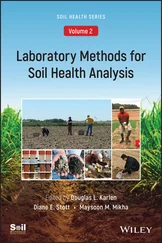Soil Health Analysis, Set
Здесь есть возможность читать онлайн «Soil Health Analysis, Set» — ознакомительный отрывок электронной книги совершенно бесплатно, а после прочтения отрывка купить полную версию. В некоторых случаях можно слушать аудио, скачать через торрент в формате fb2 и присутствует краткое содержание. Жанр: unrecognised, на английском языке. Описание произведения, (предисловие) а так же отзывы посетителей доступны на портале библиотеки ЛибКат.
- Название:Soil Health Analysis, Set
- Автор:
- Жанр:
- Год:неизвестен
- ISBN:нет данных
- Рейтинг книги:3 / 5. Голосов: 1
-
Избранное:Добавить в избранное
- Отзывы:
-
Ваша оценка:
- 60
- 1
- 2
- 3
- 4
- 5
Soil Health Analysis, Set: краткое содержание, описание и аннотация
Предлагаем к чтению аннотацию, описание, краткое содержание или предисловие (зависит от того, что написал сам автор книги «Soil Health Analysis, Set»). Если вы не нашли необходимую информацию о книге — напишите в комментариях, мы постараемся отыскать её.
Soil Health Analysis, Set — читать онлайн ознакомительный отрывок
Ниже представлен текст книги, разбитый по страницам. Система сохранения места последней прочитанной страницы, позволяет с удобством читать онлайн бесплатно книгу «Soil Health Analysis, Set», без необходимости каждый раз заново искать на чём Вы остановились. Поставьте закладку, и сможете в любой момент перейти на страницу, на которой закончили чтение.
Интервал:
Закладка:
In New Zealand, soil quality/soil health assessment was also a rigorously studied topic with one example being “Visual Soil Assessment” (VSA) guidelines for areas characterized as “flat to rolling” or “hill country (Shepherd, 2000; Shepherd et al., 2000a; Shepherd and Janssen, 2000; Shepherd et al., 2000b). Those publications provided instructions, photographs, and scorecards for using VSA to assign scores of 0, 1, or 2 for poor, moderate, or good, respectively, for a variety of soil and plant indicators. Guidelines to help land managers respond if soil quality/soil health was deemed to be either moderate or poor were provided. Inherent site characteristics including land use, soil type, texture, moisture condition, and seasonal weather conditions are also recorded.
Soil quality quickly became closely aligned with good soil management in New Zealand. Furthermore, because land‐based industries were the main generator of export income, the use of soil quality assessment as a sustainability indicator generated a substantial amount of research and technology transfer activities throughout that country (Beare et al., 1999). Increasing economic pressure to intensify land use, possibly beyond the margins of sustainability further increased farmer demand for more information, better monitoring tools, and improved soil management practices. Ultimately this led to development of a soil quality monitoring system (SQMS) by Crop & Food Research Ltd. and the Centre for Soil and Environmental Quality (Beare et al., 1999). Several soil quality web sites and other technology transfer activities also evolved during that era.
Many other New Zealand‐based soil quality studies that contributed to the foundation upon which current soil health activities have evolved were conducted, but even listing them is beyond the scope of this chapter. One study (Reganold et al., 1993) does warrant discussion because it helps illustrate that soil quality evolution during the 1990s was not without conflict and strong differences in scientific opinion. Reganold et al. (1993) evaluated soil quality and financial performance of biodynamic and conventional farms in New Zealand. They concluded that per unit area, biodynamic farms had better soil quality and were as financially viable as neighboring conventional farms. Within a year a critique questioned the statistical analyses that had been used (Wardle, 1994), but a reanalysis of the data (Reganold, 1994) confirmed the original conclusions and added information indicating that measurements collected from two of the farm pairs had twelve times more earthworms (by number) with biodynamic management than their conventionally managed counterparts.
Bouma (2000) broadened the definition further to include land quality (Bouma et al., 2002) and also explored soil quality effects on the global food supply (Bouma et al., 1998). Meanwhile, Schipper and Sparling (2000) favored the term soil condition, while many German‐language publications indicated scientists in that country struggled with differentiating between soil quality and attributes associated with soil fertility (Patzel et al., 2000). Ultimately the German Federal Soil Protection Act [ https://germanlawarchive.iuscomp.org/?p=322(verified 30 June 2020)] was passed to protect or restore soil functions on a permanent sustainable basis. That Act and others in Europe reflected viewpoints that contaminant levels should be the focus for soil quality debates (Singer and Ewing, 2000) and that the concept should be used to improve land use decisions associated with industrial and urban waste and by‐product disposal. The goal was to prevent soil property changes that would disrupt natural functions of the soil. Meanwhile, Bujnovskỳ (2000) stressed that for the Slovak Republic, soil quality assessment should focus on deriving a fair soil price and monitoring for degradation. With regard to biomass production, he concluded that was only one of many critical soil functions.
In Australia, soil quality/health research during the 1990s was focused on issues similar to those in New Zealand or the northern hemisphere. For example, Aslam et al. (1999) used MBC, MBN, MBP, and earthworm ( Apporrectodea caligninosa ) populations as biological soil quality indicators to quantify effects of converting pastureland to cropland through either plowing or no‐tillage practices. They concluded that conversion using no‐till practices could protect soils from biological degradation and maintain better soil quality than with moldboard plowing.
Europe and New Zealand were not the only locations where soil quality was intensively debated. In the United States, Sojka and Upchurch (1999) were fearful SQI and similar efforts could lead to premature conclusions advocating a value system as an end unto itself. They argued there was very little if any parallel between soil, air, and water quality, and that there were regional or taxonomic biases. Karlen et al. (2001) rebutted, emphasizing that advocates and early adopters of soil quality were in total agreement that “our children and grandchildren of 2030 will not care whether we crafted our definitions or diagnostics well. They will care if they are well fed, whether there are still woods to walk in and streams to splash in — in short, whether or not we helped solve their problems, especially given a 30‐yr warning.” That philosophical debate is mentioned simply to alert soil health advocates the road ahead may not always be smooth.
21 stCentury Developments in Soil Health
In contrast to global exponential growth in soil quality activities during the 1990s, evolution of soil health during the first ten years of the 20 thCentury showed an identifiable drop ( Fig. 2.1). A small contingent of soil scientists continued to question if such holistic research was a good investment. They stated that for more than 200 years soil science had used reductionist research to develop agricultural technologies that unlocked the hidden potential of earth’s natural systems to feed, clothe, and provide raw materials to the human population (Sojka et al., 2003). Their perspective was that soil quality proponents sought to change the scientific approach, nomenclature, and institutional priorities for soil science. Proponents countered stating that soil quality was never envisioned as “an end in itself” but rather an evaluation process to identify and quantify soil biological, chemical, and physical responses to specific soil management practices on an identifiable soil resource. They argued that soil health awareness was important because inappropriate, non‐sustainable soil management decisions were leading to environmental degradation (e.g., salinization, compaction, erosion, surface and groundwater contamination) and threatening the very soil resources opponents needed to meet 2030 desires of their children and grandchildren. Furthermore, proponents argued soil quality/soil health research, demonstrations, and educational materials simply were evaluating how well a specific soil was functioning in response to both inherent and dynamic properties and processes that can only be evaluated using biological, chemical, and physical indicators. Accusations that proponents of soil health and its assessment was intended to compete, replace, or even diminish the importance of either modern soil survey programs or science‐based soil management strategies were totally irrational and unfounded (Karlen et al., 2003b).
The philosophical debates gradually waned and many soil quality proponents quietly moved forward emphasizing soil health which originally had slightly different approaches and priorities than soil quality, but overall were very similar concepts, appropriate for assessing biological production and environmental protection (Harris et al., 1996). An unfortunate consequence of this scientific debate was that public support and even interest in soils began to wane leading to institutional changes that included dismantling the SQI.
Читать дальшеИнтервал:
Закладка:
Похожие книги на «Soil Health Analysis, Set»
Представляем Вашему вниманию похожие книги на «Soil Health Analysis, Set» списком для выбора. Мы отобрали схожую по названию и смыслу литературу в надежде предоставить читателям больше вариантов отыскать новые, интересные, ещё непрочитанные произведения.
Обсуждение, отзывы о книге «Soil Health Analysis, Set» и просто собственные мнения читателей. Оставьте ваши комментарии, напишите, что Вы думаете о произведении, его смысле или главных героях. Укажите что конкретно понравилось, а что нет, и почему Вы так считаете.












